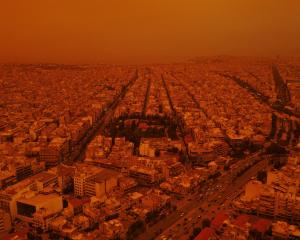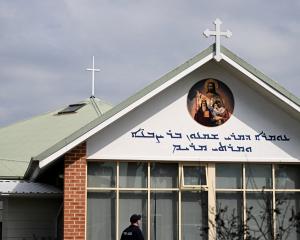Hurricane Isaac is forcing evacuations affecting tens of thousands of people in Louisiana and Mississippi, even as relieved New Orleans residents said its destruction was nothing like that seen after Hurricane Katrina in 2005.
A slow-moving Category 1 hurricane when it hit the region on Tuesday (local time), Isaac was expected to weaken into a tropical depression on Thursday. Only one fatality linked to the cyclone has been confirmed so far.
But Isaac left a soggy mess across a widespread area along the U.S. Gulf Coast and could still bring heavy rain and flooding as it moves over the central United States - where rain is badly needed - in the next few days.
More than 1 million residents of Louisiana and Mississippi were without power due to the storm on Thursday morning, according to the U.S. Department of Energy.
Fears about a possible imminent failure of the Lake Tangipahoa Dam in Mississippi prompted authorities to order the immediate evacuation of 60,000 residents in nearby communities in both Louisiana and thousands of others in Mississippi.
The dam, in Pike County, Mississippi, is about 100 miles (161 km) north of New Orleans, which was not in imminent danger.
"It was badly damaged during the torrential rains last night but it has not been breached at this time," said Carlene Statham, deputy director of Pike County Civil Defense.
The oil and gas industry in the Gulf of Mexico region has so far reported no major storm-related damage to infrastructure. Energy production was expected to start ramping up again, after nearly grinding to a halt as Isaac closed in on Louisiana on Tuesday.
Benchmark Brent crude was little changed in Thursday afternoon trading at about $112.80 a barrel.
Multibillion-dollar defenses built to protect New Orleans itself, after it was ravaged by Katrina almost exactly seven years ago, passed their first major test, according to the U.S. Army Corps of Engineers.
PLAQUEMINES PARISH FLOODED
But massive rains and storm surge from the Gulf of Mexico inundated low-lying communities outside the federal flood containment system protecting the city, forcing the evacuation of thousands of people from their homes and dramatic rooftop rescue operations.
The hardest-hit area was Plaquemines Parish, southeast of New Orleans, where floodwaters overtopped at least one levee on Wednesday and left many homes under about 12 feet (3.6 meters) of water.
Local boatmen plucked dozens in Plaquemines from the roofs of their houses after they had decided they could ride out what, compared with Katrina, seemed like a small storm.
Parish President Billy Nungesser said U.S. Army National Guard troops and local sheriff's office officials were going house to house through the area on Thursday to ensure that there were no deaths or injuries.
Clearing weather permitted the use of military helicopters, mostly UH-60 Blackhawks, to aid in the operation.
In St. John the Baptist Parish, northwest of the city, about 3,000 people were forced to evacuate their homes before dawn on Thursday due to storm surges from Lake Pontchartrain and Lake Maurepas, authorities said.
In Slidell, a town of about 27,000 people northeast of New Orleans, storm surge from Lake Pontchartrain left the Eden Isle community under about a foot (30 cm) of water.
Emergency services rescued about 350 people from Slidell homes and neighboring communities hit by more severe flooding, local authorities said.
"We've had no power and no food for two days," said Steve Bales, 45, a Slidell-based construction worker.
"We don't have a way out of town. We have nowhere to go," he added, sitting on the stoop of a city building with half a dozen townspeople.
National Guard troops and police moved into the town Thursday afternoon as some local residents plowed along flooded streets in boats.
IT WAS SCARY'
Staff Sergeant Denis Ricou, a Louisiana National Guard spokesman, said about 5,800 troops had been deployed due to Isaac and the number could rise to over 8,000 in the coming days.
City officials announced a dusk-to-dawn curfew on Wednesday to help prevent any return of the looting that occurred in New Orleans in the days after Katrina struck in 2005.
New Orleans Mayor Mitch Landrieu warned that the punishment for a looting conviction is harsh - a mandatory three years' hard labor.
"If you loot, you'll wear an orange suit," Landrieu told a news conference.
About a dozen looting-related arrests were reported in the city by Thursday morning but the streets were unusually quiet, littered with downed branches, trees and pieces of roofing material.
Power remained out through most of the city, while in the historic French Quarter, a few people were out taking down the boards they had nailed up over store windows.
Mark Wallace, 52, came out to check on his store, Fancy Boutique.
"This one just took forever," Wallace said of the slow-moving storm, which has brought rain to New Orleans since late Tuesday. "Usually they blow through and are done with."
Wayne Overton, 50, a longshoreman, came out to inspect a large, fallen tree in front of his home that had knocked down power lines. "This one lasted a while. It was scary," Overton said, noting that the storm had damaged the roof of his home, near the city's port. "There's going to be a lot of clean-up to do around here."
DROUGHT RELIEF
As the focus on Isaac shifted from the coast, many in its projected path further north have been praying it will bring rain desperately needed to ease a drought in the central states, where summer crops are drying up and many rivers and dams are critically low.
Isaac never came close to the power of Katrina, which was a Category 3 hurricane on the five-step Saffir-Simpson scale when it smashed into New Orleans on Aug. 29, 2005.
But U.S. President Barack Obama still declared the impact on Louisiana and Mississippi major disasters and ordered federal aid to supplement state and local recovery efforts.
City officials said Louis Armstrong New Orleans International Airport, which closed late on Monday, would remain shut on Thursday until repairs can be done to the damaged lines that supply it with power.
A tow-truck driver, 62-year-old Gregory Alan Parker, died early Thursday after a tree fell on his cab while he was trying to move a large tree from a main street in Picayune, a town in Pearl River County in southern Mississippi near the Louisiana border, according a spokesperson for the Pearl River Emergency Management Agency.
Together with an unconfirmed death in a Louisiana apartment fire, his was the only U.S. fatality blamed on Isaac so far. The storm killed 23 people in Haiti and the Dominican Republic on its way across the Caribbean to the Gulf of Mexico.
The U.S. National Hurricane Center said Isaac, now a tropical storm with top sustained winds of 40 mph (65 kph), was centered about 165 miles (270 km) northwest of New Orleans and churning slowly northwest.
It was followed by Hurricane Kirk, which formed on Thursday over the open Atlantic Ocean, about 1,065 miles (1,715 km) northeast of the Caribbean northern Leeward Islands, the Miami-based hurricane center said.













